
Click……click……clickety…click…click…click.
What is Click Segmentation?
Click segmentation is a process of having contacts self-segment, based on a link, or links, they click on.
Sounds kind of boring, right?
Well, I’m not going to lie. It is kind of boring.
But from a marketing point of view, using click segmentation with targeted email campaigns is really cool, really smart, and totally worth it. And how do we know that it’s worth it? Because it works.
Click segmentation improves…well…everything!
While talking to one of our marketing advisors I learned just how well click segmentation, in conjunction with targeted email campaigns, really works!
“They love it! Ever since I told them about (click segmentation) they are using it on almost all the links they put in their emails. They’ve set up automated emails that follow up with those click segments and those targeted emails are getting open rates between 67% and 82%!”
Still not convinced? Take a look for yourself…
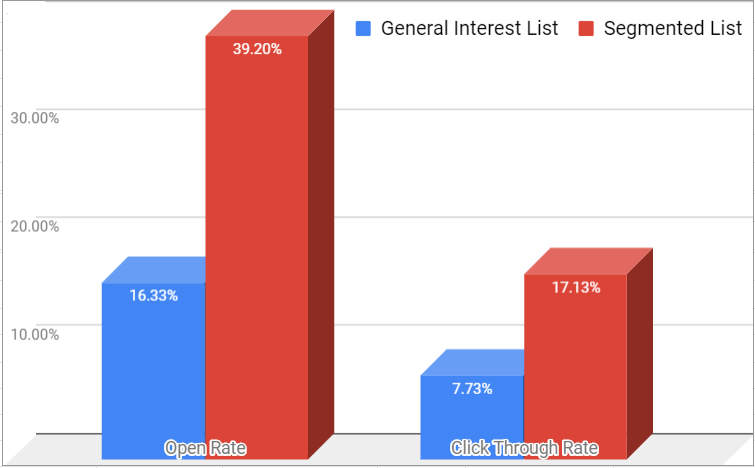
It’s clear to see that the targeted emails sent to segmented lists (in red) had a phenomenal effect on not only the open rates but also the click-through rates. We also found that it reduced the total amount of individuals who unsubscribed after receiving the targeted email, versus the general email.
So, what exactly is a segment?
A segment is a way of breaking a large group down into smaller groups of individuals with certain commonalities, based on:
- Demographics
- Geographics
- Psychographics
Unless you’re in marketing and/or advertising, you probably don’t hear those words every day.
Heck, I’m in the business but unless we’re doing research, we don’t use those words every day!
So, let’s break them down, and talk about why they might be important when segmenting your contacts.
- Demographics is basically the statistical data of a population, or, in the case of email marketing, a group of contacts. It’s used to lump people together based on their age, income, education, etc. This is plain, straight, no-frills data. Which is useful for some things, but not very personal.
- Geographics, as the word implies, is about location. And as any realtor will tell you; location is everything. But, it’s not everything to everyone. However, this is important information to obtain if you’re a realtor, a small chain of restaurants, or basically, if you’re a local business looking to draw in local customers/clients/donors, etc.
- Psychographics refers to the tastes and attitudes of a demographic. Basically, this is where people spend their time and money. This information is marketing gold. It’s the most useful, as well as the most difficult, information marketing researchers obtain.
Don’t have a team of marketing researchers? That’s where click segmentation comes in. Depending on the options you provide, through click segmentation, your contacts can provide all kinds of demographic, geographic, and psychographic information. Without ever feeling like a number, instead of a person.
Why should I use click segmentation?
The short and sweet answer is target marketing. In the email marketing world, target marketing is sending a specific email, to a specific group of your contacts. It’s like using laser sights to hit your target.
Segmenting your contacts, and sending out targeted email campaigns can:
- Improve open rates
- Improve sales/donations
- Improve customer relationships
List segmentation, with targeted email campaigns, works for all types of businesses, including nonprofits.
How do I get started with click segmentation?
Let’s say you own a massage therapy business, and you offer multiple services. You’ve set up a sign-up form on your website, and also one on your Facebook business page. Contacts are signing up every day and now you want to make sure you send the right information…to the right people.
Take time to make a plan. If you do the work now, you’ll reap the benefits every day.
First, think about: Why would someone sign up for my email list (generally)?
- Information on massage for health reasons
- Information on what services I offer
- Wanting to receive promotions/sales/coupons
Then, take a look at: What do I have to offer and/or why people use those services (specifically)?
- Swedish massage for health and/or relaxation
- Massage for Athletes for health and/or to prepare for an event
- Lymph Massage for health
Create your lists based upon your answers to the above questions.
For my example, based on the answers above, I have three primary interest lists (in addition to your general list, which should contain every contact you have):
- Health
- Services
- Promotions/sales/coupons
The idea is that everyone who signs up for your email list is signing up for one of these three reasons, if not all three (contacts can be on more than one list). Be careful with these primary lists and guard them. It is best to only send to these lists on rare or special occasions. The real work will be done by your other lists. *Hint: the beginning of a drip campaign falls within the “special occasion” category.
In the interest of keeping this as simple as possible, we’ll use just a few additional or “target” lists:
- Massage for Relaxation
- Massage for Athletes
- Lymph Massage
These are the lists that your contacts will segment themselves into, through click-segmentation.
Keep in mind that there can be as many “target” email lists as you want, or need. It all depends upon how specific or targeted, you want your lists and emails to be.
For instance, you might want to also create a list for “Athletic Event” and “Special Occasion”. The rationale for separating “special athletic event” from “special occasion” is that you don’t necessarily want to send someone who’s training for the Boston Marathon information on price cuts for booking a Bridal Party.
However, you might want to send both the Marathoner and the Bride information on how massage lowers stress.
Here’s an example of sending out an email to more than one list (don’t worry, if someone is on more than one list, they’ll only receive one copy of the email):
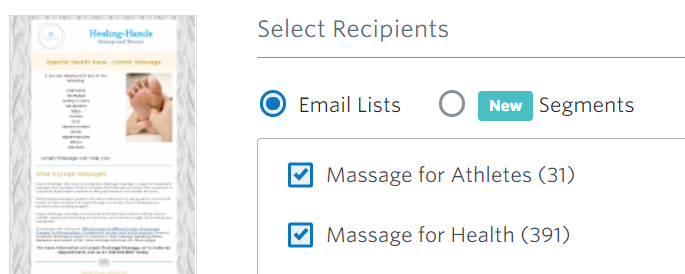
How to implement click segmentation
Now that you’ve set up your lists, it’s time to create the welcome email that will go out to new contacts when they sign up to receive your emails.
When you set up your account, there’s a general Welcome Email already in your account, but when you’re segmenting your contact lists for target marketing, make your email work for you.
Create your own Welcome Email and ask your new contacts to tell you a little about themselves, what they’re interested in, or why they signed up to receive your emails. And be sure to link all of those “clickable” answers to their corresponding lists. This is the first step to good contact segmentation.
Marketing Tip: Don’t overwhelm your contacts with too many questions at one time. Start with the primary reasons (primary lists) in your welcome email, and then use the following emails to segment your contacts further.
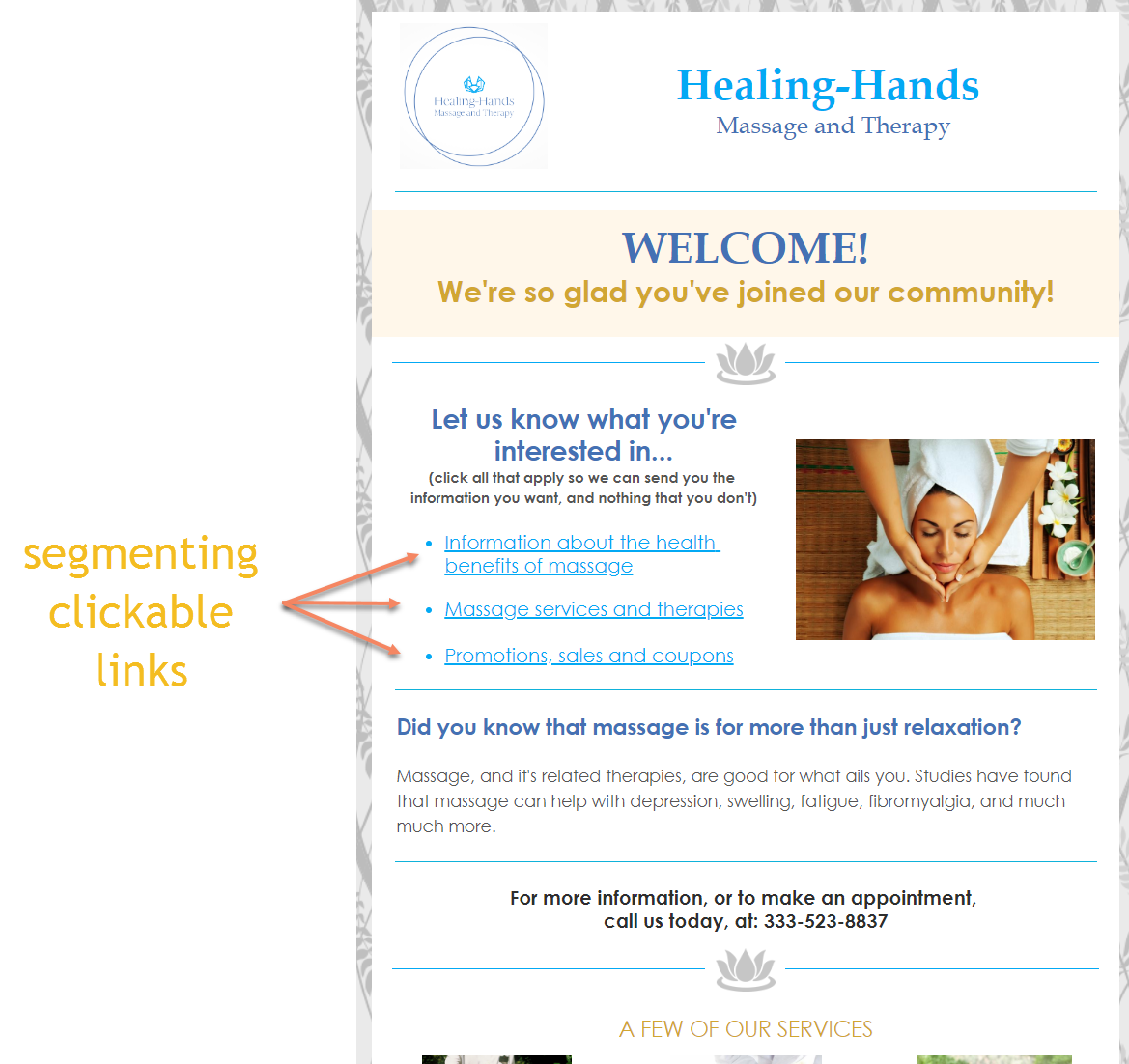
Each clickable link should direct your reader to something that they’d be interested in, based on the link title. Such as:
- An article on your website about the health benefits of massage
- Your services menu on your website
- A coupon
What do I do with my contact lists, now that I have them?
Now that you have a few primary lists, and several “target” lists set up, and your new contacts have received a Welcome Email, and clicked on their interests, it’s time to send out some targeted emails or start a drip campaign.
Here’s an example of an email targeted to individuals interested in massage for health:
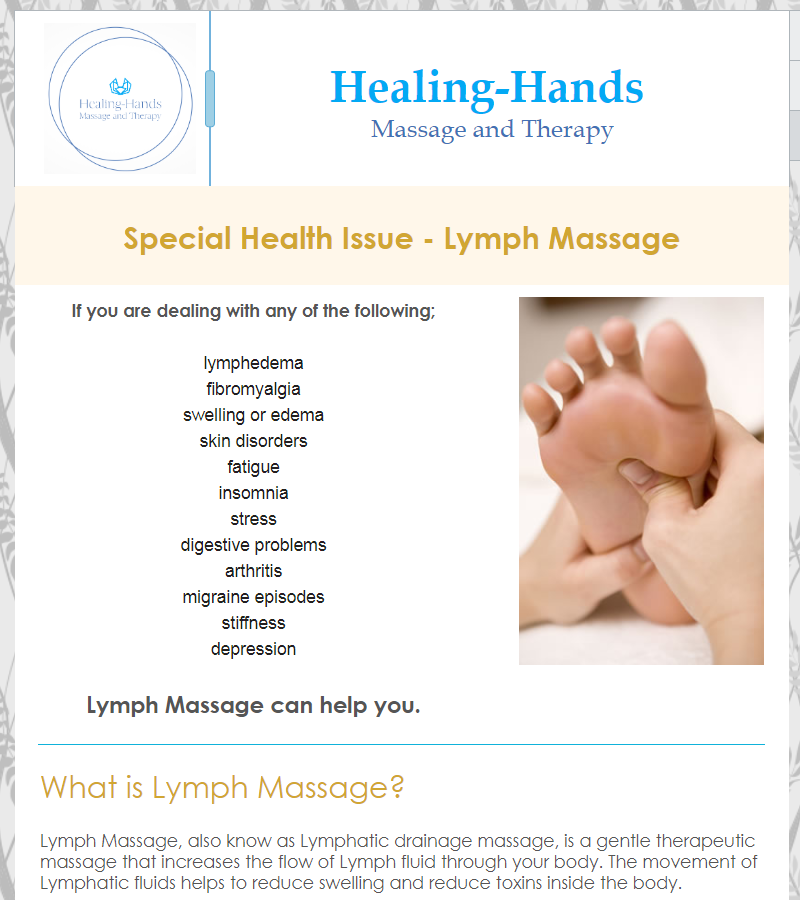
Pro Tip: Use click segmentation to start/trigger multiple drip campaigns simultaneously.
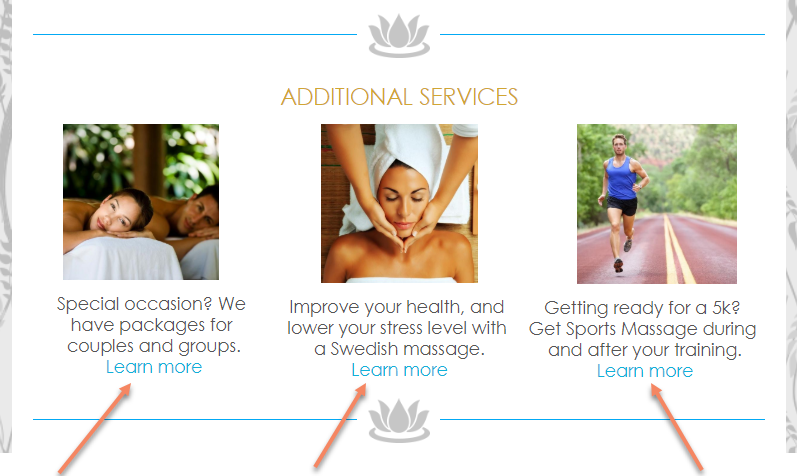
Don’t forget to include a few click segmentation links to help you further segment your contacts.
Things to keep in mind as you create and send out your email campaigns:
- Use the primary lists for general information – things like a location change, a new employee, a brand new type of service, etc.
- Use the target lists for specific, targeted emails – such as clinical info to those who are interested in health.
Be sure that you segment to a point that works for you. It’s better to be more specific, as long as your email campaigns match the segment that you’re sending to. Your lists and campaigns will grow and change with your business.
And don’t worry about segmenting too far. You can always send emails out to multiple lists, and as one of my colleagues said, “Wouldn’t it be worth sending out an email to a single individual if it results in a thousand dollar purchase?”
Want more help? Check out our ultimate guide on how to segment an email list.




